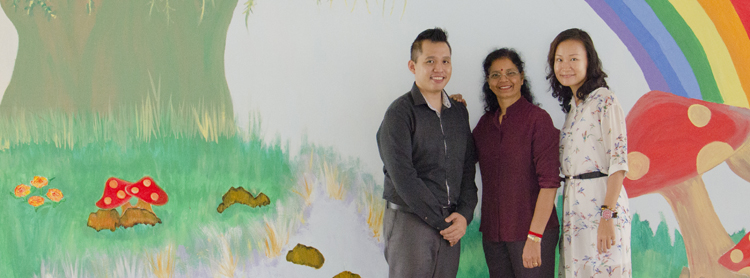Why Singapore’s English Teachers Should Embrace Singlish, Not Fight It
Is it time for Singaporean educators to embrace Singlish as a legitimate learning tool? What the Research […]
Read More
What started out as a simple weekly reflection turned into an in-depth Reflective Practice for all teachers at East Coast Primary School. Three of them share with us what happened and their biggest takeaways.
Reflecting on their own practice is something that teachers at East Coast Primary School (ECPS) are no strangers to. Since 2002, they have been penning individual reflections each week. Early this year, however, the way in which they reflected on their teaching has advanced to a whole new level.

(From left) Azhar, Ramakrishnan and Stella believe that reflecting on your own teaching can help to enhance one’s professional growth.
Mrs Ramakrishnan, a School Staff Developer and Math teacher who has been with ECPS since 1989, became acquainted with the A-Cube Change 2-D Reflective Practice Model developed by Dr Lee Ngan Hoe while studying for her Master’s degree in teaching.
Although the model was originally designed with Math in mind, she saw its potential for widespread adoption in her school, regardless of subject.
“I think this model was initially quite difficult (to adapt to),” shares Ms Stella Teoh, a Chinese Mother Tongue (MT) teacher. Mr Azhar Abdul Rashid, a Malay MT teacher, agreed with her.
In stark contrast to their previous freestyle composition of reflection, this model is more systematic and specific. “With this, it is more structured, and in a way ‘forces’ us to compartmentalize our thinking into various forms,” explains Stella. She describes the previous form of reflection as akin to recalling the lesson than detailed reflection.
Another personal challenge for Stella was coming to terms with one’s own belief system through reflective practice, about what works and what does not.
Ramakrishnan shares that “you will have to address your belief, adjust your belief, maybe to also let go of your belief at certain times.”
Before the pilot project started for 15 selected teachers at ECPS, Dr Lee Ngan Hoe from NIE conducted a school-wide workshop for all teachers. He introduced them to two reflection models to be used together (See box story below).
Previously, teachers would discuss their reflection pieces with their Reporting Officers (ROs) who read and comment on them. With the new model, reflection is done in groups.
Ramakrishnan notes that reflection used to focus on reporting and accounting instead of critical analysis. Dr Lee’s model lends structure to ECPS’s pre-existing reflection routine.
“We wanted to put in a bit of structure to our reflection, and the depth of reflection that we want in our teachers, so as to improve in our teaching pedagogies and learning in the students,” she elaborates.
The added structure provides leeway for more sharing among teachers, allowing them to discuss and bounce ideas off one another on common issues encountered in the classrooms.
This allows for pertinent issues to be highlighted and addressed across the board.
“If at the department level we are not able to address it, we will bring it up to the executive committee level, where we discuss with our school leaders and see how we can help our teachers in addressing the issues,” Azhar says.
 During their level Timetable Time meeting, Math teachers would meet and discuss about Math and the teaching of Math.
During their level Timetable Time meeting, Math teachers would meet and discuss about Math and the teaching of Math.
By analysing their lessons critically through reflective practice, teachers were able to identify what worked or did not work in class. Through this, they were able to share more details about their best practices that resulted in learning improvement.
Ramakrishnan cites an example of a reflective practice done by a teacher on a Math lesson unit on measurements. In her write-up, the teacher reflected in great detail how using something as simple as a makeshift ruler and plasticine helped her students better understand the topic at hand.
“As you reflect on your Math teaching, you find that you could have made it more interesting, or you could have made it more challenging,” notes Ramakrishnan.
If not for teachers, a model for reflective practice will simply remain as just that, a model. Ultimately, they are the ones who make all the difference in students’ educational advancement.
Ramakrishnan sums it up the best when she says, “Every lesson counts and every lesson needs to be reflected upon in order to make improvements. If you don’t reflect on a lesson, you will remain as a mediocre teacher. You will not (make the) jump and become a kind of great teacher.”
“If I reflect on my lesson, the students will benefit from my reflections as I conduct better lessons.”